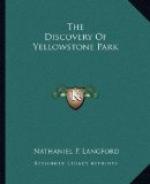While surveying these wonders, our ears were constantly saluted by dull, thundering, booming sounds, resembling the reports of distant artillery. As we approached the spot whence they proceeded, the ground beneath us shook and trembled as from successive shocks of an earthquake. Ascending a small hillock, the cause of the uproar was found to be a mud volcano—the greatest marvel we have yet met with. It is about midway up a gentle pine-covered slope, above which on the lower side its crater, thirty feet in diameter, rises to a height of about thirty-five feet. Dense masses of steam issue with explosive force from this crater, into whose tapering mouth, as they are momentarily dispelled by the wind, we can see at a depth of about forty feet the regurgitating contents. The explosions are not uniform in force or time, varying from three to eight seconds, and occasionally with perfect regularity occurring every five seconds. They are very distinctly heard at the distance of half a mile, and the massive jets of vapor which accompany them burst forth like the smoke of burning gunpowder.
Some of these pulsations are much more violent than others, but each one is accompanied by the discharge of an immense volume of steam, which at once shuts off all view of the inside of the crater; but sometimes, during the few seconds intervening between the pulsations, or when a breeze for a moment carries the steam to one side of the crater, we can see to the depth of thirty feet into the volcano, but cannot often discover the boiling mud; though occasionally, when there occurs an unusually violent spasm or concussion, a mass of mud as large in bulk as a hogshead is thrown up as high as our heads, emitting blinding clouds of steam in all directions, and crowding all observers back from the edge of the crater. We were led to believe that this volcano has not been long in existence; but that it burst forth the present summer but a few months ago. The green leaves and the limbs of the surrounding forest trees are covered with fresh clay or mud, as is also the newly grown grass for the distance of 180 feet from the crater. On the top branches of some of the trees near by—trees 150 feet high—we found particles of dried mud that had fallen upon the high branches in their descent just after this first outburst, which must have thrown the contents of the volcano as high as 250 or 300 feet. Mr. Hauser, whose experience as an engineer and with projectile forces entitles his opinion to credit, estimates from the particles of mud upon the high trees, and the distance to which they were thrown, that the mud had been thrown, in this explosion, to the height of between 300 and 400 feet. By actual measurement we found particles of this mud 186 feet from the edge of the crater.
We did not dare to stand upon the leeward side of the crater and withstand the force of the steam; and Mr. Hedges, having ventured too near the rim on that side, endangered his life by his temerity, and was thrown violently down the exterior side of the crater by the force of the volume of steam emitted during one of these fearful convulsions. General Washburn and I, who saw him fall, were greatly concerned lest while regaining his feet, being blinded by the steam, and not knowing in which direction to turn, he should fall into the crater.




